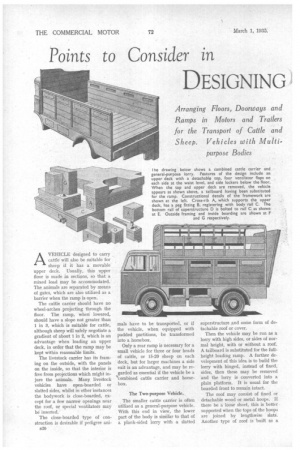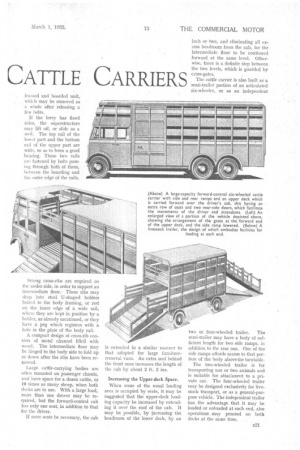DESIGNING CATTLE CARRIERS
Page 34

Page 35

If you've noticed an error in this article please click here to report it so we can fix it.
Arranging Floors, Doorways and Ramps in Motors and Trailers for the Transport of Cattle and Sheep. Vehicles with Multi purpose Bodies
AVEHICLE designed to carry cattle will also be suitable for sheep if it has a movable upper deck. Usually, this upper floor ip made in sections, so that a mixed load may be accommodated. The animals are separated by means of gates, which are also utilized as a barrier when the ramp is open.
The cattle carrier should have no wheel-arches projecting through the floor. The ramp, when lowered, should have a slope not greater than I in 3, which is suitable for cattle, although sheep will safely negotiate a gradient of about 1 in 2, which is an advantage when loading an upper deck, in order that the ramp may be kept within reasonable limits.
The livestock carrier has its framing on the outside, with the panels on the inside, so that the interior is free from projections which might injure the animals. Many livestock vehicles have open-boarded or slatted sides, whilst in other instances the bodywork is close-boarded, except for a few narrow openings near the roof, or special ventilators may be inserted.
The close-boarded type of construction is desirable if pedigree anie20 mals have to be transported, or if the vehicle, when equipped with padded partitions, be transformed into a horsebox.
Only a rear ramp is necessary for a small vehicle for three or four heads of cattle, or 15-20 sheep on each deck, but for larger machines a side exit is an advantage, and may be regarded as essential if the vehicle be a %combined cattle carrier and horsebox.
The Two-purpose Vehicle.
The smaller cattle carrier is often utilized as a general-purpose vehicle. With this end in view, the lower part of the body is similar to that of a plank-sided lorry with a slatted superstructure and some form of detachable roof or cover.
Then the vehicle may be run as a lorry with high sides, or sides of normal height, with or without a roof. A tailboard is substituted for the fullheight loading ramp. A further development of this idea is to build the lorry with hinged, instead of fixed, sides, then these may be removed and the lorry is converted into a plain platform. It is usual for the boarded front to remain intact.
The roof may consist of fixed or detachable wood or metal hoops. If there be a loose sheet, this is better. supported when the tops of the hoops are joined by lengthwise slats. Another type of roof is built as a framed and boarded unit, . which may be removed as a whole after releasing a few bolts.
If the lorry has fixed sides, the superstructure may lift off, or slide as a unit. The top rail of the lower part and the bottom rail of the upper part are wide, So as to form a good bearing. These two rails are fastened by bolts passing through both of them, between the boarding and the outer edge of the rails.
Strong cross-ribs are required on the Under side, in order to support an intermediate floor. These ribs may drop into steel U-shaped holders bolted to the body framing, or rest on the inner edge of a wide rail, where they are kept in position by a holder, as already mentioned, or they have a peg which registers with a hole in the plate of the body rail.
A compact design of cross-rib consists • of metal channel fillea with wood. The intermediate floor may be hinged to the body side to fold up or down after the ribs have been removed.
Large cattle-carrying bodies are. often mounted on passenger chassis, and have space for .a dozen cattle, or 10 times as many sheep, when both decks are in use. With a large load, more than one drover may be required, but the forward-control cab has only one seat, in addition to that for the driver. is extended in a similar manner to that adopted for large furnitureremoval vans, An extra seat behind the front ones increases the length of the cab by about 2 ft. 2 ins.
Increasing the Upper-deck Space.
When some of the usual loading area is occupied by seats, it may be suggested that the upper-deck loading capacity be increased by extending it over the roof of the cab. It may be possible, by increasing the headroom of the lower deck, by an If more seats be necessary, the cab inch or two, and eliminating all excess headroom from the cab, for the intermediate floor to be continued forward at the same level. Otherwise, there is a definite step between the two levels, which is guarded by cross-gates.
The cattle carrier is also built as a semi-trailer portion of an articulated six-wheeler, or as an independent two or four-wheeled trailer. The semi-trailer may have a body of sufficient length for two side ramps, in addition, to the rear one. One of the side ramps affords access to that portion of the body above the turntable.
The two-wheeled trailer is for transporting one or two animals and is suitable for attachment to a private car. The four-wheeled trailer may be designed exclusively for livestock transport, or as a general-purpose vehicle. The independent trailer has the advantage that it may be loaded or unloaded at each end, also operations may proceed on both decks at the same time.




























































































